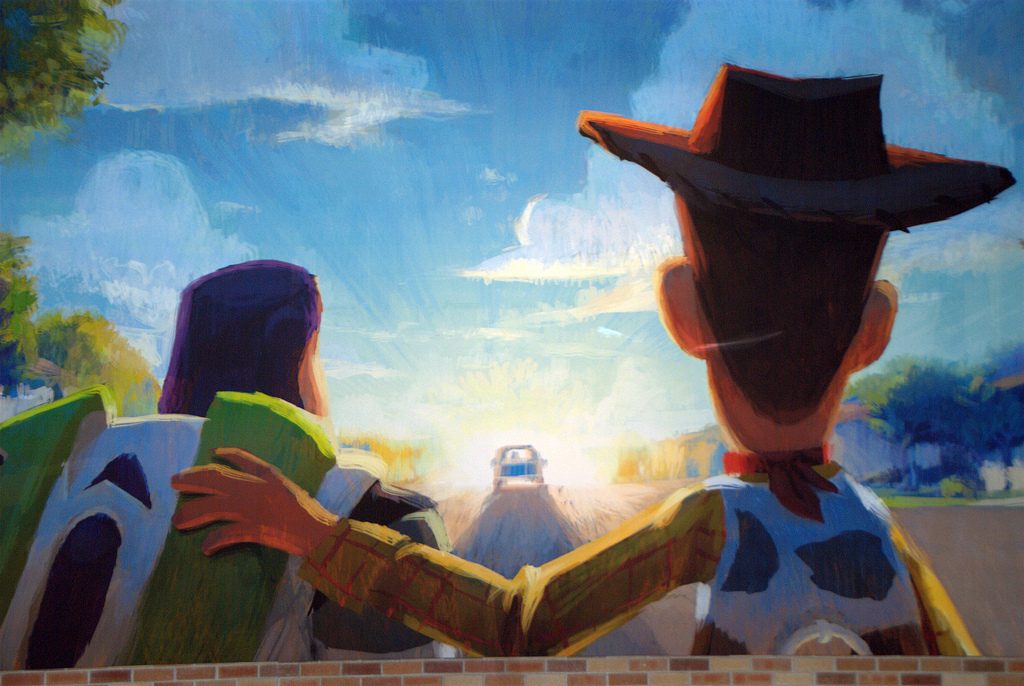Winner of the Fall 2018 StMU History Media Award for
Article with the Best Title
Best Article in the Category of “Cultural History”
“It felt like it had taken a lifetime to get to this point, and in a sense it had.”1
Most of us grew up in a world where toys came to life when Andy wasn’t looking, a world where the monsters in our closet were afraid of us, a world where houses could fly with balloons. Pixar movies have created a world of magic and infinite possibilities. They have brought life and authenticity out of technology. Pixar has created a cinematographic empire like no other. Their success was forged out of mistakes and struggles as well as passion, creativity, and determination. Pixar had to make mistakes in order to grow and create the stories we love today, and they did.
Pixar’s story really starts with three men: Edwin “Ed” Catmull, Steve Jobs, and John Lasseter.

Ed Catmull was turned down for a teaching position and felt he had landed a software development job with no future. Steve Jobs had been humiliated throughout Silicon Valley when Apple Computer, the company he founded, fired him.2 John Lasseter was fired from his dream job as a Disney animator for trying to introduce three-dimensional animation technology there. He was told that if it didn’t make movie production cheaper or faster, it wasn’t worth it.3 All of these men were at a low point in their lives when they became part of the group of people that eventually became Pixar. What brought them out of this uncertain part of their lives was a single goal: to change the way stories are told by pushing the boundaries of what computers can do in animation and graphics by creating the first computer-animated movie in history. These people became the foundation of Pixar Animation Studios.
Not commonly remembered is the company’s inception as the Computer Graphics Division for Lucasfilm, the movie studio behind the Star Wars franchise, beginning in 1979. Through a series of events, Steve Jobs ended up buying this small struggling division in 1986 for five million dollars. He also gave it its iconic name. At that point, the company was selling computer hardware with the Pixar Image Computer as their main product. Their increasingly dwindling revenue also consisted of producing commercials for companies such as Trident and Listerine.4 With their financial struggles, and no clear path into the future of movie-making, Pixar was created.
Pixar’s goal moved further out of reach as they fired one-third of the company in 1991. At that point, Pixar had only sold three hundred Pixar Image Computers. They then decided to stop selling hardware. The five million dollars it had cost Jobs to buy the company had turned into a $54 million money pit. Its only source of revenue, and future survival, was a contract with Disney to produce three movies. There wasn’t even a guarantee that they could make the movies. Nevertheless, the team decided to take a leap of faith into the unknown path of creating computer-animated movies.5
Money was tight and there was constant miscommunication between the Pixar team and Jobs. Jobs was in the middle of establishing NeXT, a computer company he started after Apple. This meant that he rarely appeared in the Pixar offices. The Pixar team felt Jobs did not understand what they needed, and Jobs felt that the Pixar team had no idea how to run a business. Lasseter and Catmull would put out an idea and Jobs would shut it down immediately: the only way was his way. Jobs was described as brilliant and inspirational as well as dismissive, condescending, and bullying. It was clear, Pixar could not survive under Jobs. He simply did not connect with the company leadership and staff, but the company could not survive without him either.6

From the year 1987 to 1991, Jobs attempted to sell Pixar three times. Catmull reflected on this time, saying, “Even if Pixar doubled in value, Steve told me, we still wouldn’t be worth anything.”7 Microsoft, Alias, and Silicon Graphics all tried to acquire the company, but Jobs never sold it. Despite taking millions of dollars of his own money just to keep it afloat, he could not sell. It was his way of saying that he had something other people wanted, something special, that Pixar was worth having, despite its flaws. Every time a company made an offer for Pixar, he acted insulted, suggesting that he believed Pixar was worth much more. It was only after critics predicted that an animated film would be a hit and that Disney signed with Pixar to make their movie, that Jobs gave Pixar one last chance.8
There emerged some hope, as they assembled an excellent but inexperienced team in 1992. Catmull and Jobs began to understand each other and collaborate, and the first computer-animated movie was in its beginning stages. Production of the movie began in early 1993. Their dream was so close that they could see it; their dream was becoming a reality. Their first movie blossomed from Lasseter’s simple idea, the story about a group of toys and a boy.9
Toy Story was going to create a revolution within the technology, art, animation, and entertainment fields. Because this was going to be their debut film under their “mentor” company Disney, Pixar story writers took every advice they gave them to heart. Disney animators were the experts, and they had the success Pixar craved. Disney perceived Woody, a toy cowboy and one of the movie’s main characters, as “too perky, too earnest.”10 An edgier Woody would create a better conflict and a better story. Or so they said.
November 19, 1993 came. It was also known as “Black Friday.” On this day, a mock-up of Toy Story was presented to Disney executives. Months of hard work had been dedicated to making this idea become a reality, and finally … Disney shut down the project. There would not be an animated movie until they fixed the script.
They had technology and talent, but the entire concept was just not right. Something crucial was missing. For the next couple of months Lasseter, Catmull, and the entire team worked every possible moment to rediscover the soul of the project. By this time, special effects were starting to enter mainstream cinematography, with movies such as Jurassic Park and Terminator 2. People enjoyed the manner in which technology enhanced the movie experience, and Pixar was ready to be part of this innovation wave.

The answer to their story problem was simple. They hit on the idea of a story of a boy and his toy cowboy. This experience taught them to trust their own abilities, to give Pixar its own character, and to do things the Pixar way.11
November 22, 1995. Toy Story was released to the world, to infinity and beyond.12
In total, Toy Story earned $362 million worldwide, it was a phenomenon. It had created an ingenious and creative new storytelling method. Now the graphics on the movie screen were perceived as having emotion and character. The movie had characters that had life in a way that was unprecedented from anything animators had done before. Pixar was able to create this emotional response because the overall theme was so human and relatable. With themes such as friendship, change, finding who you truly are, and your purpose in life, it is no surprise that though this movie was made for a young audience, it resonated with people of all ages. It was a masterpiece.13
The following year, Toy Story was nominated for three Academy Awards. John Lasseter received a Special Achievement Award. And Pixar announced its retirement from making commercials in order to focus on making more movies.
Due to its success with Toy Story, Disney pursued a partnership with Pixar. Shortly afterward, Pixar decided to open their company stock to the public. With this, they earned $140 million for the company. Pixar had accomplished something it had never done before; it was now a stable company.14
What started off as a constantly struggling company became an animation empire. Their stories have since touched the lives and hearts of people around the world. They’ve made us cry and they’ve made us laugh. Ed Catmull, Steve Jobs, and John Lasseter came together to change the world by creating the first computer-animated movie.
The rest is history.
- Edwin Catmull and Amy Wallace, Creativity, Inc.: overcoming the unseen forces that stand in the way of true inspiration (New York: Random House, 2014), 56. ↵
- David A. Price, The Pixar Touch: The Making of a Company (New York: Vintage Books, 2009), 8. ↵
- Bill Capodagli and Lynn Jackson, Innovate The Pixar Way: Business Lessons from the World’s Most Creative Corporate Playground (New York: McGraw-Hill, 2009), 31. ↵
- “Our Story,” Pixar, accessed August 31, 2018, https://www.pixar.com/our-story-1#our-story-main. ↵
- Edwin Catmull and Amy Wallace, Creativity, Inc.: overcoming the unseen forces that stand in the way of true inspiration (New York: Random House, 2014), 53. ↵
- Edwin Catmull and Amy Wallace, Creativity, Inc.: overcoming the unseen forces that stand in the way of true inspiration (New York: Random House, 2014), 51-52. ↵
- Edwin Catmull and Amy Wallace, Creativity, Inc.: overcoming the unseen forces that stand in the way of true inspiration (New York: Random House, 2014), 54. ↵
- Edwin Catmull and Amy Wallace, Creativity, Inc.: overcoming the unseen forces that stand in the way of true inspiration (New York: Random House, 2014), 53; “Our Story,” Pixar, accessed August 31, 2018, https://www.pixar.com/our-story-1#our-story-main. ↵
- Edwin Catmull and Amy Wallace, Creativity, Inc.: overcoming the unseen forces that stand in the way of true inspiration (New York: Random House, 2014), 54. ↵
- Edwin Catmull and Amy Wallace, Creativity, Inc.: overcoming the unseen forces that stand in the way of true inspiration (New York: Random House, 2014), 57. ↵
- Edwin Catmull and Amy Wallace, Creativity, Inc.: overcoming the unseen forces that stand in the way of true inspiration (New York: Random House, 2014), 57. ↵
- “Our Story,” Pixar, accessed August 31, 2018, https://www.pixar.com/our-story-1#our-story-main. ↵
- David A. Price, The Pixar Touch: The Making of a Company (New York: Vintage Books, 2009), 151. ↵
- Edwin Catmull and Amy Wallace, Creativity, Inc.: overcoming the unseen forces that stand in the way of true inspiration (New York: Random House, 2014), 60. ↵



201 comments
Reagan Meuret
I had never realized that Pixar had only become a national sensation in my lifetime, with a movie that I grew up with! I think that it is very cool that Toy Story was the movie to have made Pixar into what they are today, and I cannot fathom what my childhood would be like without all of the movies that Pixar created. This article had some great new information for me on a company I thought I knew well!
Daniel Linstead
I enjoyed reading this article due to the fact that I have grown up watching Pixar movies and still to this day watch them. This enabled me to get an understanding of where Pixar originated from and also informed me that Steve Jobs was involved in Pixar. It is a fairy tale within itself, they started of on such a rocky ground, but than they have come such a famous movie production company.
Jasmine Rocha
I love Pixar and I knew that Toy Story was revolutionary when it came to making animated movies. The article was able to empathize how Pixar was not always the company that it is now. I learned that Pixar had gone through many different things before finally choosing to create an animated movie. Not only did Pixar had so much potential on its own it was able to find that potential without having Disney at their side. Steve Jobs was an interesting character when it came to the development of Pixar because he wanted to go his own path but still wanted the best for Pixar and that was animation.
Harashang Gajjar
I love Pixar and a great fan of them. this article is really written and shows how we grew up with love from cartoons in animation studio. I was amazed knowing Steve Jobs in Pixar, he was a genius guy. great movies made by Pixar and some of them really inspire us pizza also made some good amount of movies for Disney which are ver famous.
Nathan Hartley
I chose to read this article because of the nostalgia of hearing the name Pixar. I grew up watching their movies and I love all of them. I also didn’t know that Steve Jobs was involved with the company. I also didn’t know that Pixar had a contract to make movies for Disney. Overall, I think the article was written very well and I enjoyed reading it.
Jose Fernandez
This article is great! I am a fan of Pixar movies and I enjoyed learning about how it all started. I also think the title is awesome, it really caught my attention. People around the world enjoy Pixar movies every single day without knowing how it was created. It is important to know the past about the things we like, especially when it is as interesting as this story. Toy Story is one of my favorite movies and I admire the people who had the talent and imagination to create it.
Pedro Gonzalez Aboyte
I don’ think I know anyone who would not regard Toy Story to be one of the greatest animated movies of all time. It is crazy how Pixar came to be. It all started out with three men who were in a low point in their lives and decided to create a different way to tell stories. It took a lot of time and effort and they never gave up. No matter how tough it was, they kept going and in the end, managed to create a company that is recognized worldwide for their incredible animated movies.
Antoinette Johnson
I love Pixar cartoons. They were a big part of my childhood. The struggles Steve Jobs, Ed Catmull, and John Lasseter went through to make Pixar a reality is heartening. Through it all, they pushed through the trials. They had to learn how to get along and correlate ideas to make Pixar a success. Even with everything they had to sacrifice for Pixar, they never gave up on their dream to do something different with animation. And they did some different and it was and still is a huge success.
Lynsey Mott
I love Pixar, and I love how Toy Story was their first ever movie. I feel like Toy Story changed everything and made children want to keep playing with their toys or close the door and quickly open the door just to see if they would move. Then with the last movie they had broke everyone’s hearts. I had no idea the background of Pixar and it was interesting to see how rude and ugly Steve Job was to everyone. But in the end it worked out because Pixar and Disney are two of the largest productions in the world.
Avery Looney
Everyone is familiar with what Pixar is, but most people do not know the background of the company. This article does a great job of explaining the background, struggles and then the ultimate break through of this famous company. Ed Catmull, Steve Jobs and John Lasseter never gave up on their dreams and believed in themselves and their talent. Their risk to start up Pixar ultimately paid off immensely.